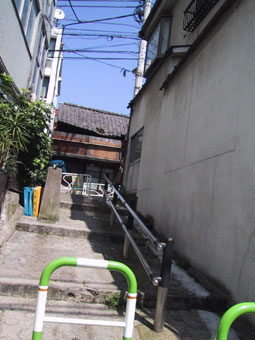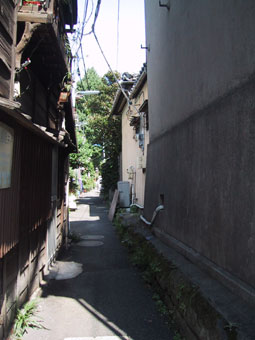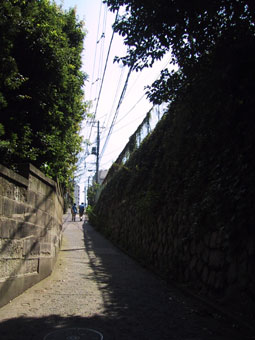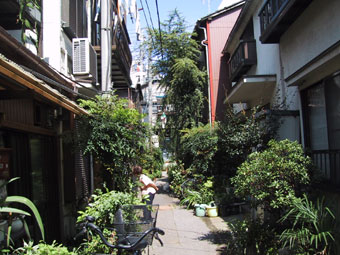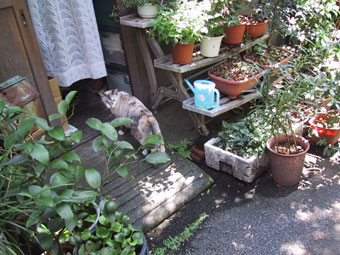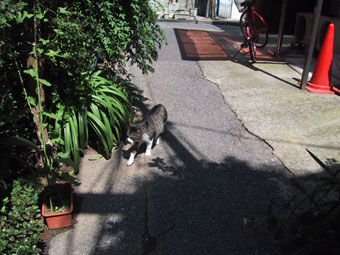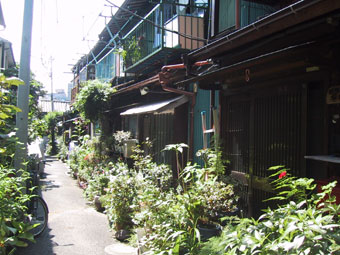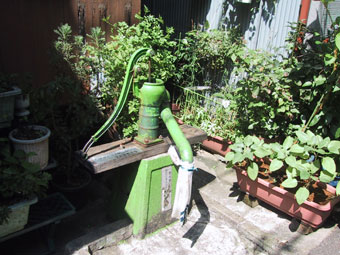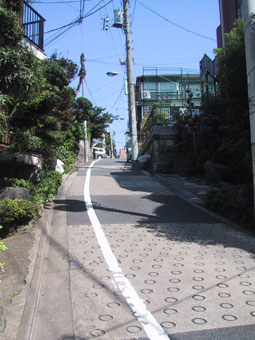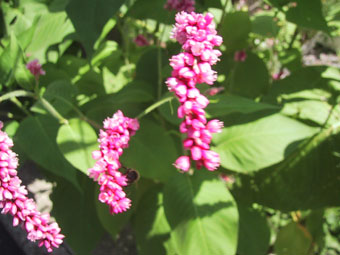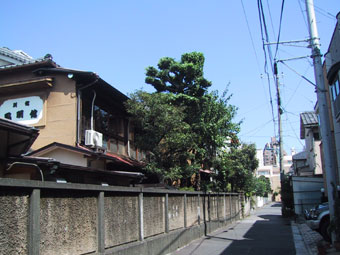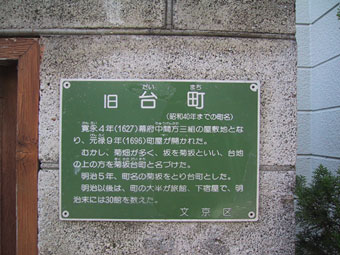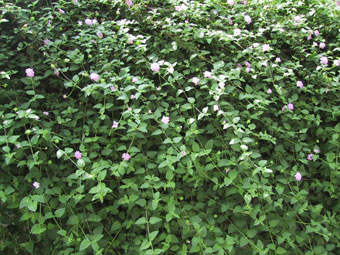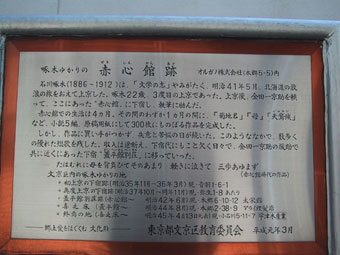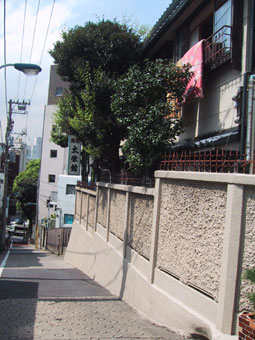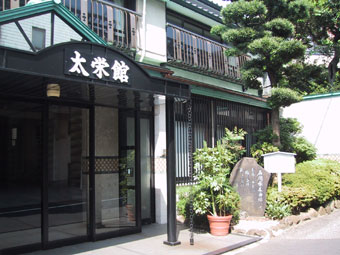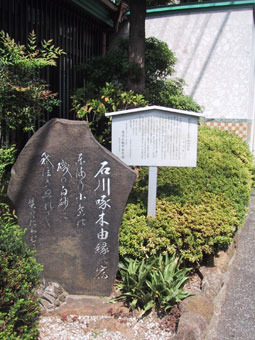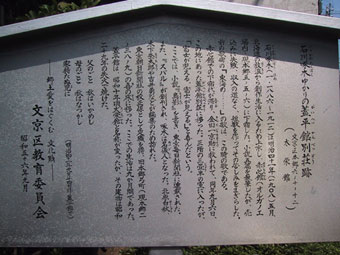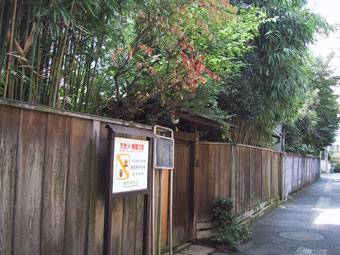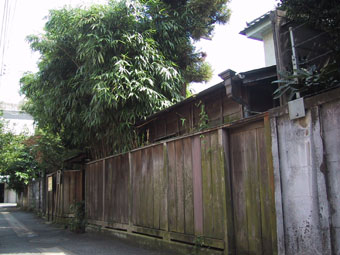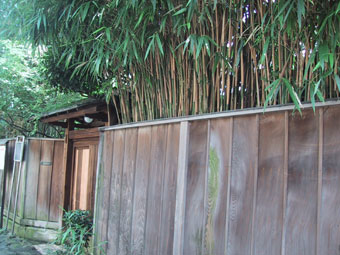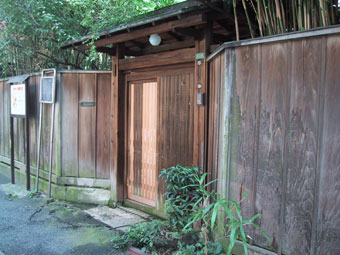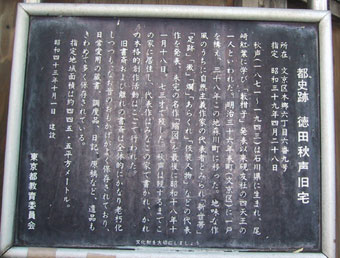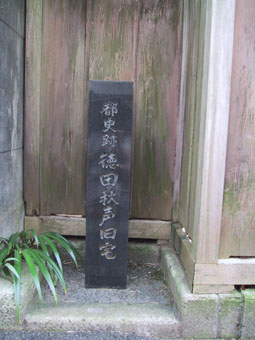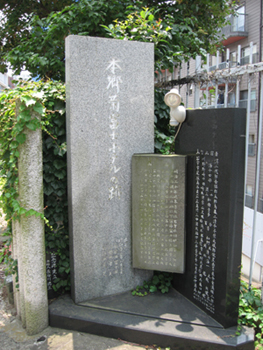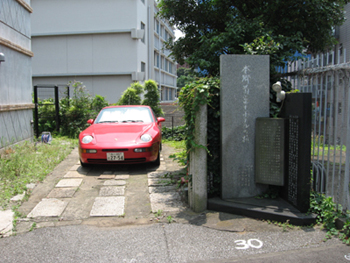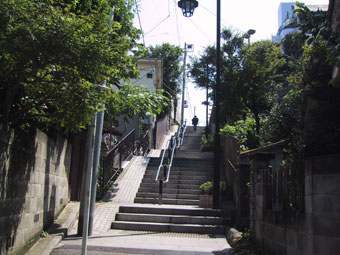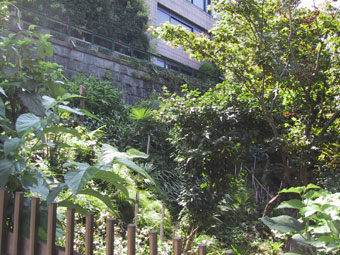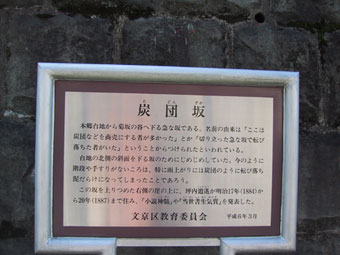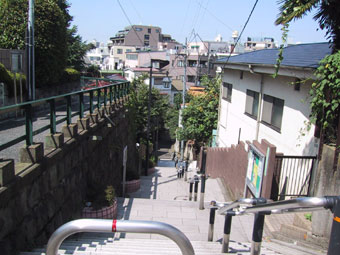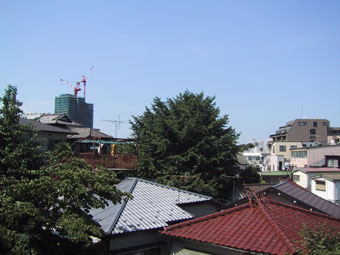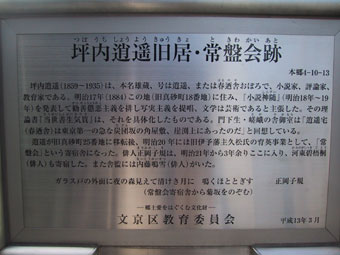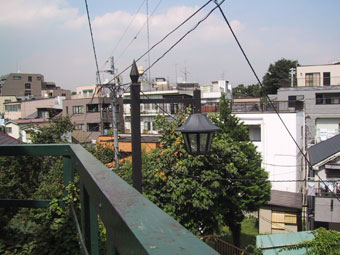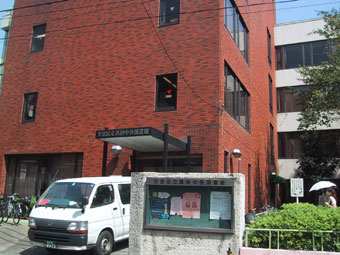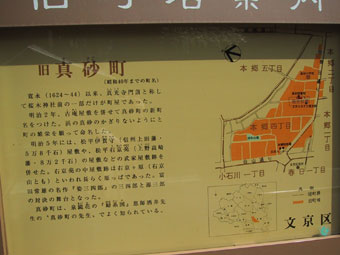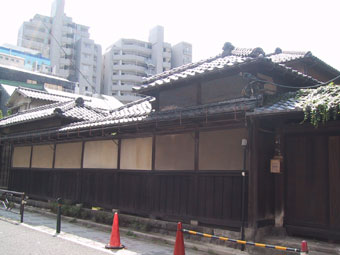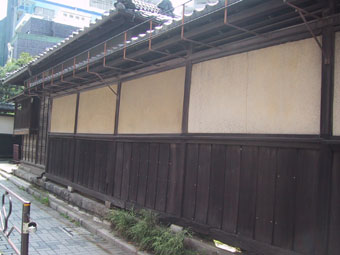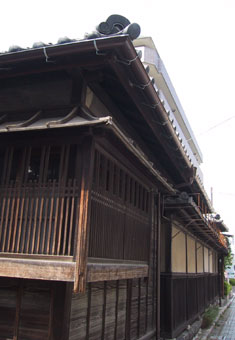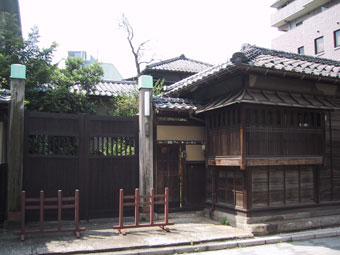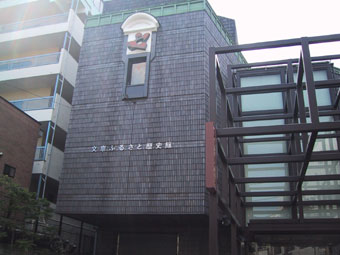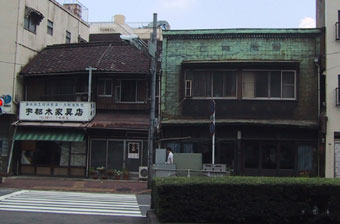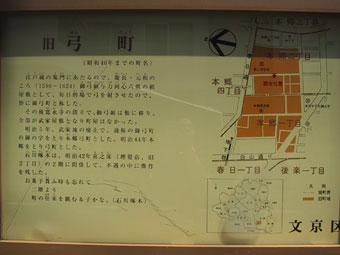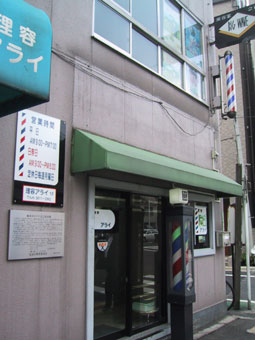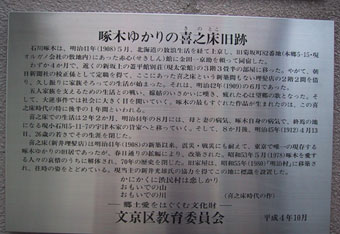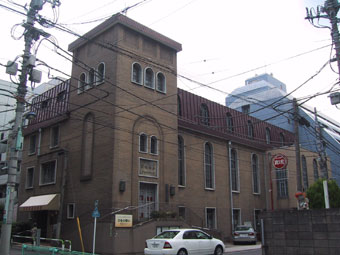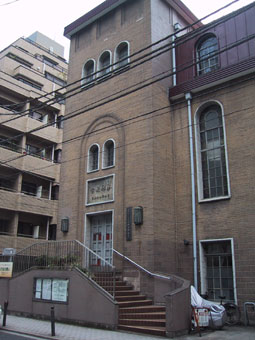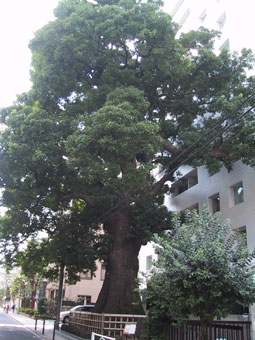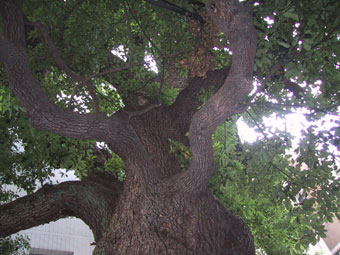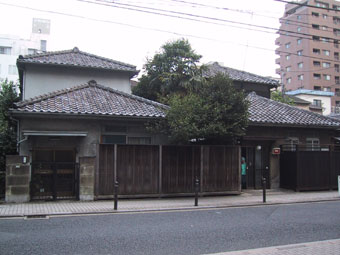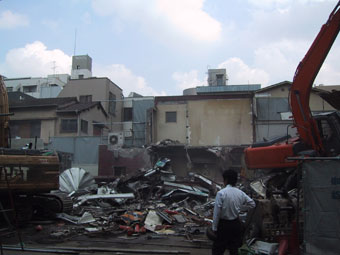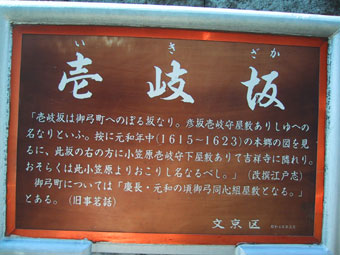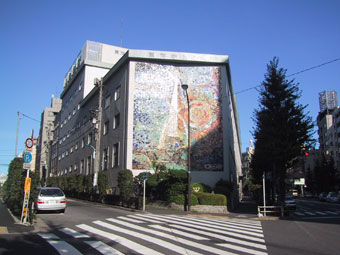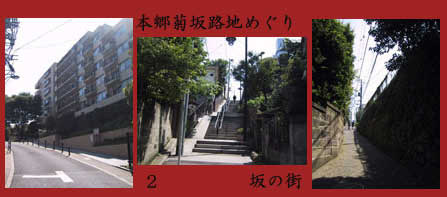
![]()
|
菊坂の南北へそれぞれ延びる坂のいくつかを上り下りしてみる。空から見下ろせば、ごく狭い地域を右往左往するばかりの筈。日陰を探し歩いても、傾斜の分だけ汗をかく。晩夏晴天の昼頃だからこんなに明るいが、普段の路地はもっと暗いのではないだろうか。坂の上で一息つくと、見晴らしがよい。坪内逍遙、樋口一葉、石川啄木、宮沢賢治、そして徳田秋声と、明治から昭和にかけてこのあたりに住んだ人々のモニュメントを辿ったあと、旧町名を残す「真砂町図書館」を経て、弓町から本郷壱岐坂へ。古い街と新しい地域の接点を求めて。 Slopes are spreading northward and southward from Kikuzaka.A bird's eye view might watch me wandering in a very small area. Ups and downs made me perspire although I walked looking for shades. Even in the brightness of early afternoon at the end of summer, I imagined it should be darker usually in back alleys. On the top of slopes, I got a fine view of the environment. Poets and writers from Meiji-Era to Showa-Era, such as Tsubouchi Shouhou, Higuchi Ichiyou, Ishikawa Takuboku, and Tokuda Shuusei, lived there. Following their monuments, I briefly stopped at Masago-cho Library and went through Yumi-cho back to Iki-Zaka. A short trip across the old and the new. |
|
菊坂を見上げる/ Looking up at Kikuzaka |
菊坂北側の路地/ An alley in the north of Kikuzaka |
|
春日通り方面へ登る坂道/ A slope leading to Kasuga-dori Avenue |
路地裏には植木鉢が所狭しと並ぶ/ Planters are placed everywhere in back alleys |
|
我輩はここの猫である/ "I'm a cat of this house!" |
我輩もこの路地の猫である/ "I also belong to this alley" says another cat. |
|
日の当たる路地/ A sunny alley |
ここの井戸も健在/ Another working well |
|
「胸突坂」/ "Munatsuki-zaka" |
坂の途中にはもう秋草(大毛蓼?)が/ Polygonum orientaoe ? |
|
胸突坂を登ったところにある旅館「鳳明館」/ A traditional Japanese inn |
ここは「旧台町」であることを示すプレート/ A plate introducing the old name of this place "Dai-machi" |
|
路地には緑も多い。丹誠込めた植木や植え込みが至るところに。/Back alleys are full of plants in pots and over fences. |
啄木ゆかりの「赤心館跡」。現在は会社の敷地。/ "A poet Ishikawa Takuboku once lived here" says the plate
|
|
菊坂下から「言問通り」を経て、再び菊坂とほぼ平行に走る「新坂」を上る。/From the bottom of Kikuzaka, via Kototoi-dori, up a barrow slope, Shin-zaka, almost parell to Kikuzaka. |
坂の途中からてっぺんにかけてある旅館「太栄館」。玄関脇に石川啄木の歌碑。/ From the middle of the narrow slope is an inn named "Taieikan," one of the sites where Ishikawa Takuboku used to stay. A stone monument with a poem of his. |
|
啄木歌碑「東海の小島の磯の白砂に/我泣きぬれて蟹とたわむる」/A stone monument engraved with lines of Takaboku's poem"Tokai no kojimano iso no shirasunani/ Ware nakinurete kani to tawamuru"(In a beach of the eastern sea of white sand/ I cry in tears playing with crabs) |
かつてこの地に石川啄木が逗留した下宿「蓋平館別荘」があったことを示す立て札。/ A board telling Ishikawa Takuboku in poverty once stayed in a lodging house called "Gaiheikan Annex" which located here.
|
|
旧森川町にある徳田秋声宅。/ The house of a novelist Tokuda Shusei in Morikawa-cho. |
板塀に被さる篠竹の繁み/ The bamboo bush over the wooden wall |
|
ひっそりした小路/ A very quiet lane |
作家のお孫さんが今も書斎を始め、邸宅を守っておいでとのこと。表札は雨風に吹きさらされて読めない。非公開。/ The writer's grand child lives here and maintains his house including old writings. The house is not open to the public. |
|
「徳田秋声旧宅」が東京都指定の史跡であることを示す看板。/ This plate tells that the house of Tokuda Shusei is designated as a special historic site of Tokyo.
|
御影石の都史跡標/ A stone mark of a historic site of Tokyo |
|
|
文人の集った本郷菊富士ホテル跡(左の写真も)/ Where Hotel Kikufuji used to be.(The left photo is also the same.) |
|
菊坂下の路地を歩くと「炭団坂」に通じている/ Tadon-zaka |
「炭団坂」の途中から崖上を振り返る/ Looking up from the middle of Tadon-zaka |
|
「炭団坂」の由来を示すプレート/ A plate introducing Tadon-zaka |
「炭団坂」上から菊坂下路地を見下ろす/ Looking down from the top of Tadon-zaka |
|
「炭団坂」上からの眺望/ A view from the top of Tadon-zaka |
「炭団坂上」にある坪内逍遙旧居跡のプレート/ A plate on the summit of Tadonzaka telling this is the site where Tsubouchi Shouyou (a novelist, critic, scholar and the first translator of Shakespeare in Japan) once lived and taught his student . |
|
懐古調のランプ型街灯/ A nostalgic shape of the light |
文京区立真砂中央図書館/ Bunkyo-ku Masago Central Library |
|
旧真砂町の町名案内板/ A plate introducing the original name of this place; Masago-cho |
炭団坂の上、図書館前の古い屋敷「諸井邸」/ An oldfashioned Japanese house of Morois, surrounded with a wall made of wood and clay, which is in front of Masago Central Library |
|
長屋門を巡らした構え/ Nagaya-mon (the wall in which servants of the mansion lived in old days) |
長屋門の格子窓 / The lattice of the window of nagaya-mon wall
|
|
屋敷正面の門。敷地には西洋館もある。/ The main gait of the estate in which there is a western style building as well. The mixure of Japanese and foreign styles. |
図書館前の通り中程にある「文京ふるさと歴史館」/ The Local Historic Museum of Bunkyo on the lane of Masago Central Library |
|
春日通りの「宇都木屋家具店」正面/ The old building of a furniture shop, Utsuki-ya, in Kasuga-dori Avenue |
旧弓町を表示する地図/ A map indicating Yumi-cho, the old name of this area. |
|
春日通り弓町側にある、啄木が家族と二階に間借りした「喜ノ床跡」。現在も代々床屋のアライ理髪店。/ The site of "Kino-toko," where Ishikwa Takuboku lived with his family on the second floor. |
啄木ゆかりの「喜ノ床跡」を示す説明板。/ A plate explaining where Ishikawa Takuboku once lived: "Kino-Toko," a barber shop.
|
|
春日通りを超えた、図書館の通りの延長線上にある「弓町教会」/ Yumichyo Christian Church
along the Library Lane across Kasuga-dori Avenue |
教会入り口の階段/ Front steps into the church |
|
弓町教会のはす向かいには樹齢600年<高さ24mの大楠。大樹背後の建物の一階は仏蘭西料理の店『楠亭』/ AcrossYumicho Christian Church is a huge camphor tree 600 years old and 24 meters high. On the ground floor of the building behind the tree is a French Retaurant Kusunoki-Tei. |
大楠の木の力強い枝/ Powerful branches of the camphor tree
|
|
壱岐坂手前にある、現在では「古風な」家屋。マンションが隣接する。/ An "old house" right before Ikizaka |
古い建物が取り壊されていく。/ Old buildings are being crushed.
|
|
楠亭をまっすぐ行くと「壱岐坂」にぶつかる。 17世紀に遡る壱岐坂の由来を説くプレート。/ Go straight the lane of the camphor tree, you come across a slope, originated in the 17 century, "Ikizaka." |
壱岐坂(左)と新壱岐坂(右)の分岐点に立つ東洋学園大学の建物。いずれの坂も上り詰めると「本郷通り」にぶつかる。/ A building of Toyo Gakuen University between Ikizaka (left) and Shin-Ikizaka (right) both of which lead to Hongo-dori Avenue.
|
| 参考書籍 『江戸・東京文庫8江戸の名残と情緒の探訪 本郷界隈を歩く』(街と暮らし社刊 2002) |
本郷菊坂路地めぐり 1 「市井」へ/ To Hongo Kikuzaka 1
本郷菊坂路地めぐり 3「一葉の面影 霜月の町」へ / To The Relics of Higuchi Ichiyou / Kikuzaka, Hongo 3
